The Sun Replaced With Other Stars
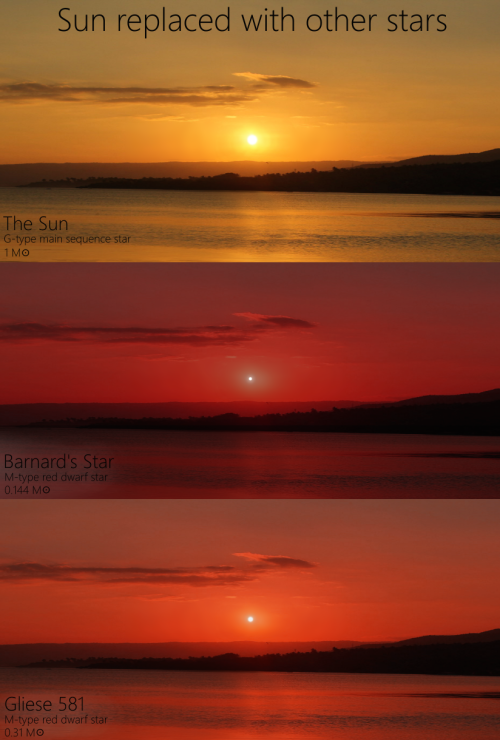
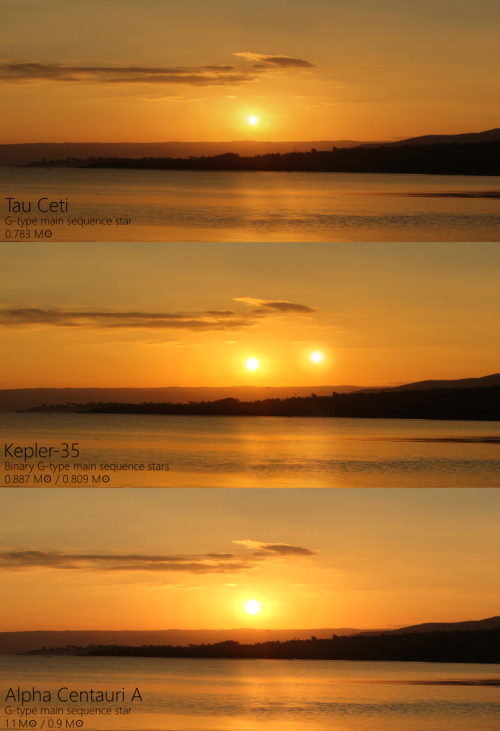
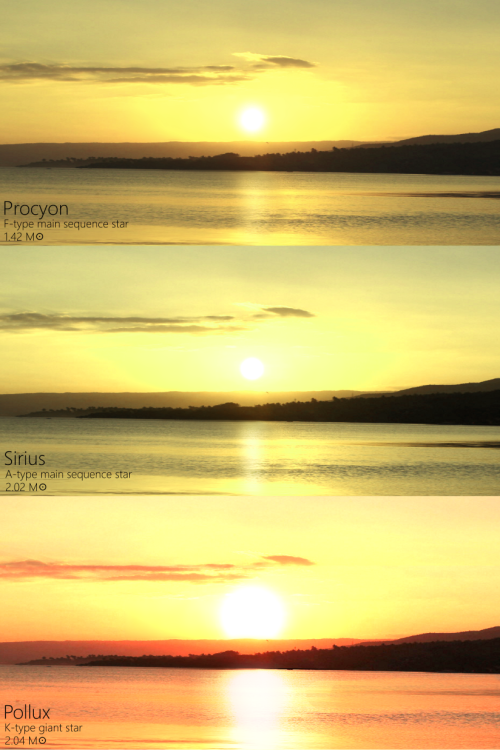
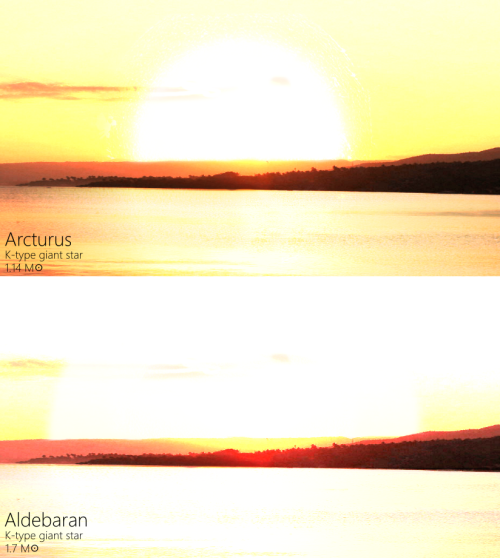
The Sun replaced with other Stars
This visualization shows how the sunset could look like to a human observer if our Sun was replaced by some of the other stars in our galaxy with different sizes and magnitudes, namely Barnard’s Star, Gliese 581, Tau Ceti, Kepler-23, Alpha Centauri A, Procyon, Sirius, Pollux, Arcturus and Aldebaran.
It is just a concept, as liquid water and the Earth as we know it could not exist in the vicinity of the most stars in this graphic. Visualizations are based on the absolute brightness, spectral class and the radius of each star.
by Martin Vargic
More Posts from Catchconstellations-blog and Others
My Constellation
I was born with stars in my eyes.
I mean this in a very literal sense! I was born in an island village that didn’t have any electricity, on a clear moonless night when millions of bright stars unfurled across the dark sky. And (according to my baby pictures) my hospital cradle was right next to the window which afforded a wide view of the ocean waves and – yep, that’s right – the stars. One of my earliest memories is that of the stars, though I’m not sure if that is from when I was a baby, or when I was slightly older.
Nevertheless, the night sky and its bright inhabitants have been constants in my life for as long as I can remember. From as early as my toddling years, I would always make it a point to my parents to let me stay outside long enough to stargaze. I didn’t know why I was so fascinated with the night sky – it was just instinctive to look up and be in wonder. My love for the stars became so apparent that my grandparents, aunts, and uncles decided to save enough money to buy me a secondhand telescope, a gift that I cherished until I had to move to the United States and leave it behind to my younger relatives.
That telescope opened up a new world for me, one where I only had to look through a pair of simple lens to excitedly meet my nighttime friends face-to-face. While the telescope wasn’t very advanced, it was strong enough to show me the faint outlines of neighboring planets, the tail-ends of occasional comets, and the blurry but beautiful glows of twinkling stars. “There’s stuff out there! STUFF!” I remember saying to my family after my first time looking through the telescope, “there’s a bunch of stuff! So much stuff!”
From there, it was inevitably easy to fall in love with outer space and all of its complications and mysteries. My curiosity and questions about the “stuff” I saw grew in leaps and bounds, propelling me to – in essence – attack our local library to get my hands on anything related to space. I was overjoyed to see an entire shelf dedicated to space science and astronomy. But when I finished devouring the texts there a few weeks later, I was devastated. Surely there was more to read, more to learn more out there?
Can you imagine, then, how I reacted when I was told that my parents and I were moving to America? The America that had sent people to the moon, built incredible spacecrafts and satellites that were currently circling the globe in low orbit, and helped found the International Space Station? I was ecstatic, and my hopes for the future far outweighed my reservations about leaving the only home I had ever known.
If there were any reservations, though, they disappeared the moment I woke up at some point during the 22-hour flight, looked out my tiny plane window, and saw with wide eyes…
… the stars – right there – right in front of me – right within my reach. At eight years old, I genuinely thought the plane was flying in a sea of stars, and kept my face mushed against the glass until a plane attendant asked me to close the window (I did close the window, but I opened it again after she left.)
It’s funny, looking back at that starry-eyed eight-year-old. I want to tell her that there’s only so much more to look forward to. I want to tell her that when she’s ten, she’s going to visit a place called Kennedy Space Center and firmly declare to everyone in the tour group that she will become an astronaut one day. I want to tell her that when she’s thirteen, she’ll visit another place called the Orlando Science Center and peek through an enormous telescope that will show her the distant planet of Saturn in color, and she’ll be so shocked that she’ll ask if the picture was a sticker on the lens. I want to tell her that when she’s eighteen, she’ll gain two mentors who will encourage her to pursue her love for the stars, and help her get started on the path to getting there… I want to tell her that the next eleven years won’t be easy, and there will be times when she’ll feel as if the stars could never be more far away or unreachable.
But I think she’ll end up just fine. She was born with stars in her eyes, after all.
List of Online Resources
Over the past week I’ve been compiling a short list of online resources I often use when I’m doing anything space-related online, whether it be writing summaries of news updates or trying to understand some complicated science topic. Hope these are useful!
On getting up-to-date news:
ScienceDaily
Space.com
Science Mag
On understanding scientific topics:
Crash Course
Khan Academy
Space Exploratorium
Of course, there are many resources out there, but these are the ones I use most often.
Beautiful! Would like to visit all of these places someday <3









World’s largest salt flat: Salar de Uyini, Bolivia
Historic Milestone in Space Flight Technology
Today, March 30, 2017, marks a significant and critical step in making affordable space travel more possible than ever.
Last April, the whole scientific community worldwide was watching as Elon Musk’s SpaceX successfully launched and landed the Falcon 9 rocket booster, proving for the first time in space flight history that it was possible to save and collect rockets after being launched into space. This March, SpaceX aims to up its standards by relaunching and re-landing the same rocket booster, which will deliver a communications satellite into orbit for a Luxembourg-based telecommunications company.
Why is this important? Simply put, rocket boosters are the most expensive part to build for any type of rocket. While SpaceX claims to have the most affordable rocket launches in the world, solidifying the concept of 100% reusable rocket boosters can save space programs $18 million per launch and open more doors for cost-effective commercial space travel.
If 100% reusable rocket boosters become a reality, the cost of launching rockets, experiments, and people into space can be significantly lowered to the point where non-scientific commercial space travel can be a common occurrence.
I can only wonder, then, how much and how far this development will impact not only the space industry, but the whole world itself. If this pushes through, there can be few excuses, then, for not recognizing the potential in looking beyond our own orbit and planet. With incredible scientific progress and discoveries happening almost every day, I think it’s only a matter of time before everyone sets their sights on the stars and starts pushing for interstellar travel.
We are no longer limited to our own solar system, and the possibilities that come with recognizing and answering to that are as unfathomable as space itself.

(via A Knight's Mission to Mars)
Hey everyone! I recently had the opportunity to work on and publish an article about student opportunities in the space industry in the University of Central Florida’s student-run publication Imprint. Please feel free to check out my article and see the other awesome work Imprint has!
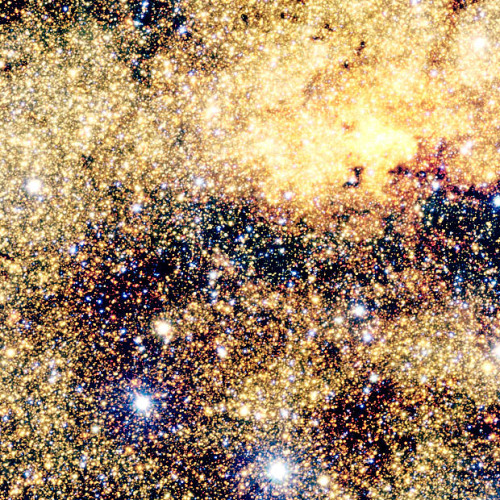
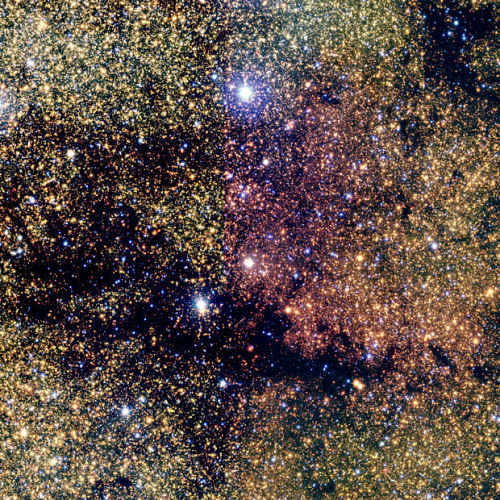
Milky Way Shows 84 Million Stars in 9 Billion Pixels
Side Note: The two images shown above are mere crop outs from ESA’s recent hit: The 9 Billion Pixel Image of 84 Million Stars. These two focus on the bright center of the image for the purpose of highlighting what a peak at 84,000,000 stars looks like.
Astronomers at the European Southern Observatory’s Paranal Observatory in Chile have released a breathtaking new photograph showing the central area of our Milky Way galaxy. The photograph shows a whopping 84 million stars in an image measuring 108500×81500, which contains nearly 9 billion pixels.
It’s actually a composite of thousands of individual photographs shot with the observatory’s VISTA survey telescope, the same camera that captured the amazing 55-hour exposure. Three different infrared filters were used to capture the different details present in the final image.
The VISTA’s camera is sensitive to infrared light, which allows its vision to pierce through much of the space dust that blocks the view of ordinary optical telescope/camera systems.
source
United Arab Emirates’ Plan for a Mars City
It seems that everyone is really starting to get into the race to Mars! The project, dubbed “Mars 2117”, envisions a completely functioning human community on the surface of the red plane by year 2117.
According to the Emirates Mars Mission main website, Mars 2117 is a specific goal that the UAE hopes will encourage international cooperation in space exploration and scientific discovery. This ambitious project also falls under a larger umbrella of aerospace goals that the UAE has set out since 2014 when they first showed interest in entering the space industry. Some of these goals include sending an unmanned probe to Mars by 2021, studying Earth’s atmosphere using advanced technology, and collaborating with scientists worldwide.
The Mars 2117 project is an incredible vision, one that I am excited to see grow and gain more attention in the years to come. While there are many initiatives around the world that aim at reaching the famous red planet, this is the first time that an entire nation has so publicly announced support and planning for such an enormous long-term project, and looks to be moving with forward momentum.
I can only wonder what other nations and organizations are thinking about this concept, as well as marvel at how much attention the space industry has garnered recently. It seems as if there are new technical discoveries and achievements being made everyday, and it doesn’t look like the space race is stopping. With SpaceX and NASA already testing advanced aero-spacecraft for future launches, and the Dutch Mars One Mission currently under progress, Mars 2117 certainly adds more fuel to the fire.
A century is certainly a long time and anything can happen between 2017 and 2117, but I can’t wait to see what happens until then.
Let me start off by saying that I think Crash Course is a great resource for people who want to get the basic details of any subject the creators offer. CC’s series for astronomy is particularly wonderful. The science behind astronomy and space can be mind-boggling due to the complexities of physics, mathematics, photonics, and other relevant subjects; CC makes it easy and fun to learn about astronomy without being too technical or in-depth. Great series of videos if you have time to check them out!
Hey Dianne. I love love love this theme! It is sooo cool. I have no idea how you did it (was it witchcraft?!?!). I love that you have this calming music playing as well. everything is just awesome --Jennifer Holden
Hi Jennifer, thank you so much for visiting my blog! The theme took forever to edit and format, but I think it’s totally worth it :D
-
 amitybrightlights liked this · 1 month ago
amitybrightlights liked this · 1 month ago -
 dat-inspiration reblogged this · 11 months ago
dat-inspiration reblogged this · 11 months ago -
 laurellancesource liked this · 1 year ago
laurellancesource liked this · 1 year ago -
 oxfordenglishdictionary reblogged this · 2 years ago
oxfordenglishdictionary reblogged this · 2 years ago -
 cheloneuniverse liked this · 2 years ago
cheloneuniverse liked this · 2 years ago -
 marshmallowtiddies liked this · 2 years ago
marshmallowtiddies liked this · 2 years ago -
 cavern-of-shenanigans reblogged this · 2 years ago
cavern-of-shenanigans reblogged this · 2 years ago -
 branchgodforever reblogged this · 3 years ago
branchgodforever reblogged this · 3 years ago -
 n3v3r3v3rrr reblogged this · 3 years ago
n3v3r3v3rrr reblogged this · 3 years ago -
 camdennightingale reblogged this · 3 years ago
camdennightingale reblogged this · 3 years ago -
 camdennightingale liked this · 3 years ago
camdennightingale liked this · 3 years ago -
 maawi1253 liked this · 4 years ago
maawi1253 liked this · 4 years ago -
 eze77nqnsur liked this · 4 years ago
eze77nqnsur liked this · 4 years ago -
 crystalcako reblogged this · 4 years ago
crystalcako reblogged this · 4 years ago -
 megagata liked this · 4 years ago
megagata liked this · 4 years ago -
 quartermind reblogged this · 4 years ago
quartermind reblogged this · 4 years ago -
 thelustfulkid reblogged this · 4 years ago
thelustfulkid reblogged this · 4 years ago -
 thelustfulkid liked this · 4 years ago
thelustfulkid liked this · 4 years ago -
 beca1959-stuff reblogged this · 4 years ago
beca1959-stuff reblogged this · 4 years ago -
 beca1959-stuff liked this · 4 years ago
beca1959-stuff liked this · 4 years ago -
 thunderboltii reblogged this · 4 years ago
thunderboltii reblogged this · 4 years ago -
 thunderboltii liked this · 4 years ago
thunderboltii liked this · 4 years ago -
 jpgeso liked this · 4 years ago
jpgeso liked this · 4 years ago -
 past-and-futur-another-worl-blog reblogged this · 4 years ago
past-and-futur-another-worl-blog reblogged this · 4 years ago -
 mavengirl444 liked this · 4 years ago
mavengirl444 liked this · 4 years ago -
 pophack liked this · 4 years ago
pophack liked this · 4 years ago -
 limplylimerent liked this · 4 years ago
limplylimerent liked this · 4 years ago -
 coldironempathy liked this · 4 years ago
coldironempathy liked this · 4 years ago -
 passeracea liked this · 4 years ago
passeracea liked this · 4 years ago -
 fookit liked this · 4 years ago
fookit liked this · 4 years ago
CONSTELLATION: (noun) Group of stars that form a recognizable pattern to which a mythological or earth-based name is assigned Pattern of stars whose name or is associated with different stories and meanings Story told by stars connected across the infinite night sky, overlapping with countless other stories that have unfolded from ancient supernovas, whose imaginary lines urge our eyes up from the chaos of the world around us to the unknown vastness in which we are but a speck of dust -------- Hi! I’m a starry-eyed astrogeek named Dianne who loves absolutely everything that has to do with the stars and outer space. When I’m not studying or preparing to take over NASA one day, you can find me trying to stargaze despite city lights or happily planning my next road trip.
35 posts
